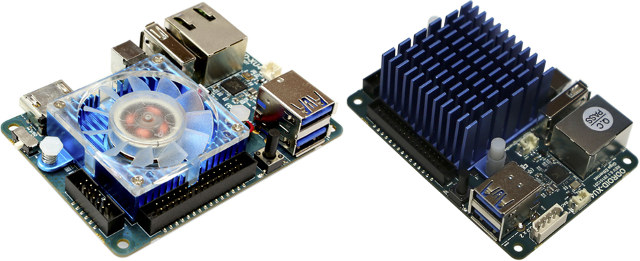[Update May 2018: You may be interested in ODROID-XU4Q review with Ubuntu 18.04]
We had already seen ODROID-XU4 development board price drop to $59 earlier this year, but a frequent complain about the board remained: it requires a fan to operate at full speed, and makes noise while the fan turns. To address this issue, the company has now launched ODROID-XU4Q board with exactly the same specifications with Samsung Exynos 5422 octa-core processor, 2GB RAM, eMMC module support, Gigabit Ethernet, USB 3.0, HDMI 1.4 etc…, except the fan is replaced by a large heatsink.

The company has also thoroughly tested both versions in different configurations such as setting the maximum frequency to 1.8 or 2.0 GHz, and found ODROID-XU4Q to be slightly slower under high load due to CPU throttling, as the large heatsink does not cool quite as well as the smaller heatsink in combination with a fan. However in many cases, the difference is minimal as shown by Antutu results (61,112 vs 60,283 points). Running sysbench at 2.0 GHz showed one of the biggest gaps in performance, with XU4Q taking 16% more time (420 seconds vs 362 seconds) to complete the test as shown below.

If you run the board at 1.8 GHz, the difference decreases to just 6%. If you are using ODROID-XU4 as part of a build farm, you may want to keep using the actively cooled version, it takes take 25 minutes to build the Linux kernel against 30 minutes on ODROID-XU4Q.The company also found that if you don’t want throttling at all, you need to set the CPU frequency to 1.2 GHz.
The company also had to add a cut out line to ODROID-XU4(Q) cases to allow for the taller heatsink. If you have a ODROID-XU4 board with a fan, and would like to convert it into a quitet ODROID-XU4Q board, you can do so by purchasing a similar (but not exactly the same) heatsink for $4.90 + shipping. The price for ODROID-XU4Q board is the same as for ODROID-XU4 ($59 + shipping).
If you’re wondering when the next major update of ODROID board is coming, there is a clue in ODROID Magazine April 2017:
In 2017, we are planning another 64-bit ARM platform and a 64-bit x86 platform, and we are also considering an upgraded version of XU4.

Jean-Luc started CNX Software in 2010 as a part-time endeavor, before quitting his job as a software engineering manager, and starting to write daily news, and reviews full time later in 2011.
Support CNX Software! Donate via cryptocurrencies, become a Patron on Patreon, or purchase goods on Amazon or Aliexpress




